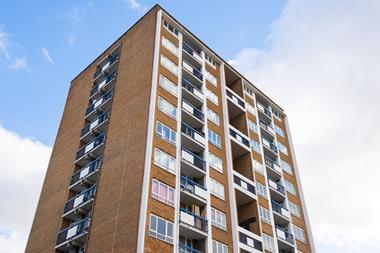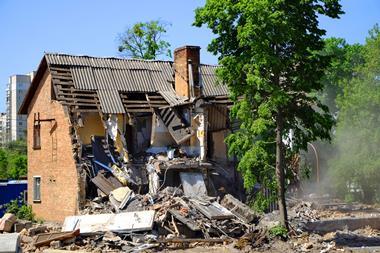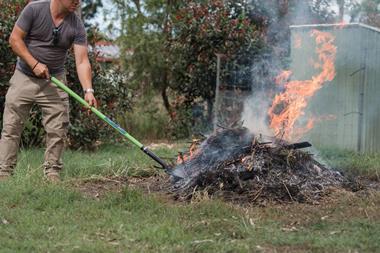Five years on from the Grenfell Tower incident, and fire safety legislation is still being rolled out, the latest measure from the Scottish government, however, places brokers at the forefront of customer education
Brokers will have a major role to play following the latest fire safety legislation from the Scottish government because homes that are not compliant with the new rules may see the validity of their home insurance policy questioned.
Having an interlinked alarm means that if one alarm rings, all other alarms at the property will also ring - this is useful if residents are in a part of the property that is furthest away from the original source of the fire.
Applicable for homes in Scotland only, the new legislation came about due to the Grenfell Tower fire in June 2017, which killed 72 people.

Peter Blanc, group chief executive of Aston Lark, told Insurance Times: “Our job as brokers is to advise clients on risk mitigation and loss prevention, as well as arranging insurance policies.
“Brokers are actively communicating with customers about this new legislation and are helping customers ensure that they are compliant.
“Hopefully, wide take up of these risk improvements will ultimately reduce fire losses and, in turn, the premiums that customers pay.”
‘Varied’ insurer responses
Mark Richards, director of private clients at Scottish broker Bruce Stevenson, warned that compliance with Scotland’s new regulations is important beyond legal reasons.
He explained: “Our advice to clients is always to adhere to the new legislation, whether or not implementation is required by their insurer - not only for their own safety and that of third parties, but also because the stance of insurers may change in time.”
For example, although Bruce Stevenson has approached many home insurers on how non-compliance might impact policy cover, Richards said that insurers’ responses have so far been “varied”.
He continued: “It would be ideal if there was a single approach from the insurance industry on this, but I can also understand that arriving at a standardised approach can take a while to crystalise following new legislation being introduced.
“Maybe it will take some claims activity to harmonise [insurers’] approach.
“Most [insurers] have said that [the new regulations] would not influence a claim and that all they require is that their own fire alarm requirements, normally attached to higher value residential properties, are adhered to.”
In addition, insurers and governments have different risk management aims when it comes to fire safety, Richards added.
“While insurers take the safety of policyholders and third parties seriously, their policy requirements are aimed at mitigating fire damage to property and the financial interest thereof, while the new legislation is aimed at preventing harm and loss of life,” he explained.
Sarah Smith, head of underwriting for home, pet and travel at LV= General Insurance said its home insurance customers in Scotland will continue to be covered for fire claims after February 2022 if an alarm isn’t fitted.
”However, we would strongly encourage all our customers across the UK to check they have interlinked smoke and carbon monoxide alarms installed and regularly checked to help protect them and their homes,” Smith said.
Meanwhile, Evan Moore, Zurich’s head of personal lines underwriting, said: “We do not have any conditions relating to fire alarm protection in our standard home policies, and there are no current plans to make any changes.
”In the event of a fire, cover will operate as normal. Although non-compliance is not considered a criminal act, we would strongly encourage all policyholders in Scotland to do their utmost to comply with the new legislation to protect themselves and their families in the unfortunate event of a fire.”
The ABI, meanwhile, stressed that insurers would expect households and businesses to be “compliant with any legislation on requirements for the property”.
An ABI spokesperson said: “It will be for individual insurers to decide how they respond to the new standard. Anyone who is unclear on their policy terms and conditions in relation to the new law in Scotland should speak to their insurer.”
Commercial property ramifications?
In terms of landlords being affected by the newly implemented fire alarm rules, Stuart Daws, head of loss control engineering at insurer Allianz, noted that the main impact of the legislation will hit private homes rather than rented accommodation. ”From a commercial viewpoint, we are not expecting to see any significant changes in what is required of landlords,” he said.
This is because the UK already has country-wide legislative requirements for landlords around fire safety, including that they install smoke and fire detectors, or provide firm alarms if renting out larger residential properties or accommodation with multiple occupation.
“We would expect such protection and detection measures to be identified as part of the owners’ own fire risk assessment. Allianz’s commercial insurance customers in Scotland will continue to be covered for fire claims after February 2022,” Daws added.

Edinburgh-based Mark Webster, building consultancy director at Sedgwick, said the loss adjuster is remaining ”tuned into” conversations around the new legislation ”because we are expecting that we might have some customers that have concerns”.
”We are trying to make sure we are listening to those concerns,” he continued.
Fire remains a tangible risk
Hundreds of thousands of homeowners and leaseholders in high-rise flats are still living in “potentially dangerous buildings”, despite the publicity of the Grenfell Tower fire, according to David Gear, head of major and complex loss for Scotland and Northern Ireland at Sedgwick.
In a blog published on 10 February 2022, titled When the Cladding Crisis meets an Insurance Policy, Gear said: “Billions have been invested in building safety, including government assistance and privately funded schemes, to replace unsafe cladding that increases the risk of fire spread.
“These initiatives have principally been aimed at buildings over 18 metres high with non-aluminium composite material (ACM) cladding - an unsafe cladding system.”
With this in mind, the secretary of state for levelling up, housing and communities Michael Gove set out new measures in mid-February, targeting companies that manufactured defective cladding - this could see these firms foot a portion of the £9bn bill ringfenced to resolve outstanding building safety issues in England.
What are the new Scottish fire safety legislation?
Under the new Fire Safety and Smoke Alarm Regulations, which came into force on 1 February 2022, all homes in Scotland must have interlinked smoke and heat alarms in the property’s living room, hallways and landings, as well as a heat alarm in the kitchen.
An interlinked smoke alarm means that if one alarm rings, all other alarms at the property will also ring. These cost around £400.
Many Scots were unaware of the rule change - there were widespread demands to postpone it.
In January 2022, Scottish conservative shadow housing and local government secretary Miles Briggs MSP said: “The [Scottish National Party has] already postponed this scheme once, but that isn’t enough.
“[It] must postpone it once again to guarantee that homeowners are fully prepared for these significant changes.”
What do Scottish homeowners need to do to comply with the legislation?
To comply with the regulation, an interlinked alarm needs to be in the room that occupants spend the most time in, with further alarms in every circulation space on each storey - such as hallways and landings. There also needs to be an interlinked heat alarm installed in the kitchen.
All smoke alarms must be mounted on the ceiling and interlinked.
Carbon monoxide detectors will also be needed if the household has a boiler, gas fire or gas hob. These do not have to be interlinked, but they do need to come with long-life, tamper proof lithium batteries. This means the batteries cannot be removed for the lifetime of the product.
When announcing the legislation on 15 February 2022, the Scottish government said: ”No one will be criminalised if they need more time and there are no penalties for non-compliance. However, we would encourage everyone to install these alarms, which can help save lives.”
What about associated costs?
Any installation costs will be the responsibility of homeowners and landlords. These will depend on what the homeowner or landlord currently has in place and which alarms they choose to install.
Hosted by comedian and actor Tom Allen, 34 Gold, 23 Silver and 22 Bronze awards were handed out across an amazing 34 categories recognising brilliance and innovation right across the breadth of UK general insurance.




















































No comments yet